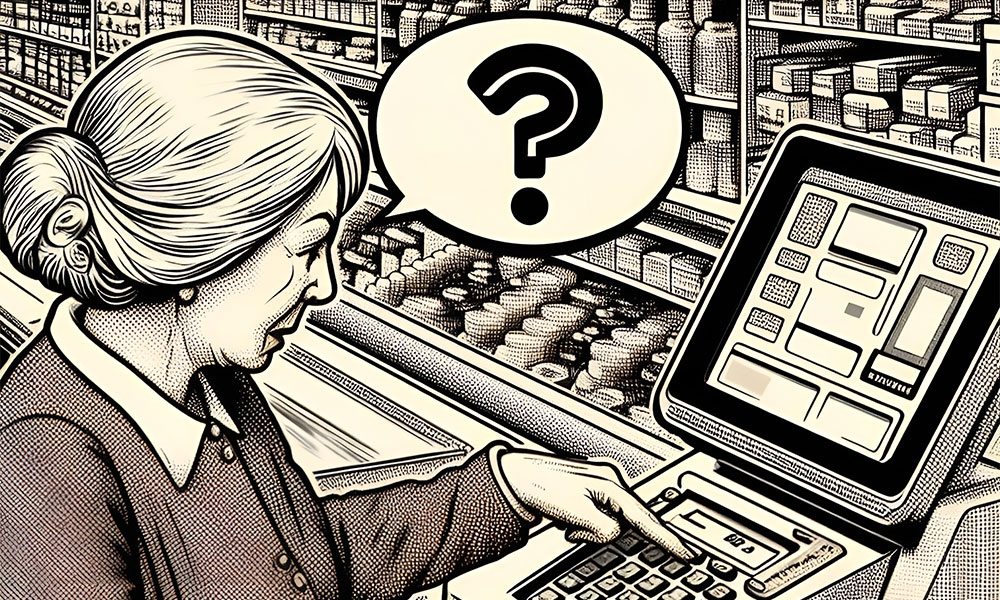 Contact
About Us
Articles
Home
Contact
About Us
Articles
Home

In the rapidly evolving world of commerce and customer relations, a seismic shift has occurred in how businesses provide service to their customers. Gone are the days when customer service was predominantly a realm of direct, in-person interactions, where a smile and a handshake were as much a part of the experience as the service itself. In recent years, a significant transformation has occurred, steering customer service away from these traditional methods and toward digital platforms. This shift, largely driven by the pursuit of greater efficiency and increased profit margins, has led to the widespread adoption of technologies such as mobile applications, QR codes and automated systems.
The implications of this digital revolution in customer service are far-reaching and multifaceted. On one hand, these technological advancements have introduced new levels of convenience and speed, changing the customer service landscape into a more efficient and streamlined process. For many, especially the tech-savvy and the digitally literate, this shift has been a welcome change. However, it's crucial to recognize that these advancements have not been universally beneficial. A significant segment of the population, particularly older consumers, finds itself grappling with these rapid changes. For them, the move away from traditional customer service to digital platforms represents not just a challenge but a fundamental barrier.
As a group that may not be as comfortable or familiar with digital technology as younger generations, older consumers often find themselves at a distinct disadvantage in this new era. The shift to digital platforms can present obstacles ranging from basic usability issues and a steep learning curve to more profound feelings of disconnection and alienation. This transition raises important questions about accessibility, inclusivity and the potential loss of the personal touch that has long been a hallmark of quality customer service.
The transformation of customer service from traditional, face-to-face engagements to digital mediums signifies a pivotal change in the landscape of consumer interactions. This evolution has been driven by a confluence of factors, fundamentally altering the way businesses and customers interact. Those factors include:
The shift to digital customer service is characterized by its focus on efficiency, cost-effectiveness and adaptability to the growing digital marketplace. However, this transformation also signifies a move away from the human-centered approach of traditional customer service, raising questions about the implications of such a change, especially for demographics less accustomed to or comfortable with digital technology.

The rapid digitalization of customer service, while beneficial for many, poses significant challenges for older consumers. This demographic, which often does not share the same level of comfort or familiarity with digital technology as younger generations, faces unique customer-service challenges that include:
There's no doubt that the shift to digital customer service can present a range of challenges for older consumers, from the struggle to develop digital literacy to the emotional and practical implications of this change. These challenges highlight the need for more inclusive customer service strategies that consider the diverse capabilities and preferences of all consumer groups, especially the elderly.

The shift away from traditional, human-centric customer service to digital platforms has had a significant impact across various industries. However, this transition has been particularly noticeable in certain key sectors such as banking, retail and health care. These industries, integral to daily life, have undergone digital transformations that, while offering benefits like increased efficiency and accessibility for some, have inadvertently created barriers for older consumers.
In the banking sector, the move toward online and mobile banking has been rapid. While digital banking offers convenience with features like online account management, electronic bill payments and mobile check deposits, it has also reduced the availability and necessity of in-person banking services. For many older adults, who may prefer face-to-face interactions for complex transactions or simply lack the confidence in navigating online banking platforms, this shift can lead to difficulties in managing their finances . Moreover, the closure of physical bank branches in favor of digital services has further limited their options.
The retail industry has also seen a significant move toward digital platforms. Online shopping, self-checkout kiosks and digital payment systems are becoming increasingly common. While these advancements streamline the shopping experience for many, they can be challenging for older consumers who are not accustomed to such technology. The lack of assistance in navigating digital payment systems or online shopping portals can make everyday purchases a daunting task. Additionally, the reduced number of staff available for in-person assistance in stores can leave older shoppers feeling unsupported and isolated.
Perhaps one of the most critical areas impacted by the digital shift is the health care industry. Telemedicine, online appointment scheduling and electronic health records have become more prevalent. These digital services can provide significant benefits in terms of accessibility and efficiency; however, for older patients, they may pose challenges. Difficulties in using telemedicine platforms, confusion over accessing electronic health records or the inability to schedule appointments online can impede their access to health care. Furthermore, the personal interaction with health care providers, which can be crucial for older patients, is often diminished in these digital exchanges.
Beyond these industries, the digitalization of customer service affects a wide range of everyday transactions and services, from using public transportation to interacting with government agencies. The assumption that all consumers are digitally literate excludes a significant portion of the older population, leading to a gap in service accessibility.

The digital divide, a term that has gained increasing relevance in today's technology-driven society, is particularly poignant when considering the challenges faced by older adults. This divide is more than just a gap. It's a chasm that separates those who are proficient in digital technology from those who are not. This disparity is starkly evident in the older generation, many of whom did not grow up in the digital age and, as a result, find themselves at a significant disadvantage in a world increasingly dominated by digital interactions.
Older adults, many of whom may have had limited exposure to computers and the internet during their working lives, often find themselves struggling to keep pace with the rapid advancements in technology. While younger generations navigate these digital landscapes almost intuitively, older individuals may grapple with even the basic functionalities of modern digital devices and platforms. This gap in digital proficiency can lead to a sense of alienation and frustration, further widening the divide.
One of the most pressing issues arising from the digital divide is the lack of accessibility in digital customer service platforms. Many of these platforms are designed with the assumption that users have a certain level of digital literacy and physical ability to interact with them. This design philosophy can result in interfaces that are not user-friendly for older adults, who may have limitations in vision, hearing or motor skills, making navigation and comprehension challenging. For instance, small text sizes, complex menus and the need for precise touchscreen interactions can be significant barriers.
Another critical aspect of the digital divide is the diminishing availability of alternative, non-digital means of accessing services. As businesses and services increasingly push their customers toward online platforms, the availability of traditional methods, such as telephone-based customer service or in-person assistance, has decreased. This shift effectively marginalizes those who are either unable or unwilling to engage with digital platforms, leaving them with few alternatives to access essential services.
The digital divide also highlights the need for targeted digital education and support for older adults. While there are initiatives aimed at improving digital literacy among seniors, these are often not widespread or well-publicized. Moreover, the training needs to be tailored to address the specific challenges and learning styles of older individuals, ensuring that it is both effective and empowering.
Addressing the accessibility issues in digital platforms requires a shift toward more inclusive design practices. This means creating interfaces and experiences that are easily navigable and understandable by people of all ages and abilities. It involves considering factors like clear and larger text, simple navigation menus, voice-assisted technology and the provision of clear, step-by-step instructions.
As the world continues its relentless march toward digitalization, the enduring importance of human interaction in customer service becomes ever more evident, particularly for older consumers. The shift toward digital mediums, while offering efficiency and convenience, often lacks the personal touch and empathy inherent in human interactions, elements that are especially valued by the older generation.
The psychological benefits of human interaction in customer service are profound, especially for older adults who may be more prone to feelings of isolation or loneliness. Personalized service, characterized by direct communication, empathy and understanding, can significantly enhance their experience. It provides a sense of connection and belonging, something that automated digital systems struggle to replicate. This human element can transform a routine service interaction into an opportunity for meaningful connection, offering reassurance and a sense of being valued and heard.
From a practical standpoint, speaking directly to a human representative can significantly simplify the process of seeking assistance or resolving issues. Older consumers often find it easier to explain their needs or problems verbally rather than navigating through a series of digital menus and options. Human representatives can also offer immediate clarification and guidance, adapting their responses to the specific context of the inquiry, which automated systems may not be able to do.
The presence of human interaction in customer service plays a crucial role in building customer satisfaction and loyalty. Older customers, in particular, are more likely to remain loyal to a service or brand that provides personalized, empathetic interactions. This loyalty is not merely a reflection of their satisfaction with the product or service itself but also their appreciation for being treated with respect and understanding.
For complex or sensitive issues, the human touch becomes even more critical. Older adults may have specific needs or concerns that require a nuanced and compassionate approach, something that automated systems are not equipped to handle. A human representative can offer tailored advice, provide emotional support and ensure that the customer's needs are adequately addressed.
To maximize the benefits of human interaction in customer service, there is a need for focused training and skills development for customer service representatives. This training should emphasize not only the technical aspects of the products and services but also the development of soft skills such as empathy, patience and effective communication. Equipping representatives with these skills ensures that they can provide the high level of service that older customers appreciate.
Alliance America is an insurance and financial services company dedicated to the art of personal financial planning. Our financial professionals can assist you in maximizing your retirement resources and achieving your future goals. We have access to an array of products and services, all focused on helping you enjoy the retirement lifestyle you want and deserve. You can request a no-cost, no-obligation consultation by calling (833) 219-6884 today.


